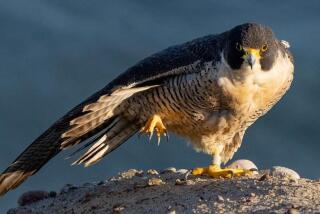Bird Counters Watch Skies for Signs of County’s Ecological Health
What compelled four grown men to wander through the dawn of New Year’s Day with binoculars and well-thumbed picture books, making “pssssst” noises at the brush in Ventura’s Arroyo Verde Park?
Birds.
While some Venturans slept in, these devoted bird-watchers were out counting hawks, finches and ravens for the Audubon Society’s annual bird census of the city. The men used the noises to flush birds into view, the binoculars to spot them and the books to identify them so that each species could be recorded.
The count is one of two in Ventura County; the other was conducted last Sunday by the Audubon Society’s Conejo Valley chapter. More than 1,000 such events across North America help the Audubon Society track pollution, extinction and changes in the birds’ habitats.
“It tells you a great deal overall about how the birds are actually doing,” said count coordinator Virgil Ketner. “Birds have a way of being affected by the environment much more rapidly than people, so when they start losing habitat, the count goes way down on a particular species.”
In the early 1970s, the count helped document the damage done to the Santa Barbara Channel’s brown pelican population by DDT that thinned the birds’ eggshells and decreased successful hatches, said Virgil Ketner, this year’s count coordinator.
And this year, it is tracking the slow decline in the overall bird population that has accompanied the five-year drought--a decline caused either by birds migrating to wetter areas or dying off for lack of water, he said.
Ventura is ranked among the top 10 cities in North America for bird spotting because the habitat varies widely from the marshes to mountains. Last year, 66 observers in Ventura spotted 179 species, including 27,886 individual birds, Ketner said.
This year, about 70 observers spotted 189 species, he said. The number of individual birds will not be tallied until later, he said.
On Wednesday, high winds kept many birds hidden in trees and the count lower than in recent years.
“It’s been a rather disappointing morning,” said schoolteacher Marvin Kwit as he strolled through Arroyo Verde, noting common birds such as ravens and yellow-rumped warblers. “The wind, it just keeps them down, they just don’t want to be buffeted about.”
Moments later, a mottled tan bird of prey swooped low over the green lawn, broad wings tracing a graceful loop through the air.
Kwit and his companions whipped their binoculars up to their eyes to track it, then paged through their bird-spotting guides.
“That’s a Cooper’s hawk,” said Pete Triem, who nurses injured birds to health at the Raptor Rehabilitation and Release Program in Simi Valley. “That’s a nice bird.”
For Kwit, it was the first such hawk he had ever seen.
“That’s a ‘life bird’ for me,” he said, smiling. “That’s a good way to start the new year.”
With 27 species spotted by midmorning, Kwit and the others trooped off to scout the arroyos of eastern Ventura for other species.
Meanwhile, another party of bird-watchers roamed through Canada Larga, near Ventura’s northwestern border.
“We’ve seen about 215 rock doves,” said Anna Marie Lea, grimacing slightly at the large number of what most people would recognize as common pigeons.
But the day also brought some good sightings:
Lea spotted a shrike--battleship gray with sharp black and white markings--while others spotted vesper sparrows and a pair of California bluebirds.
Lea said she started “birding” out her back window years ago, trying to identify the birds that came to her feeder.
Now she hikes along Canada Larga every year with a tripod-mounted, high-powered spotting scope over her shoulder, and she admits, “I got hooked on it.”
“Birding is really interesting,” said Jan Lewison, a retired diplomat who has been spotting birds in the count for 15 years. “You never know what you’re going to see.”
More to Read
Sign up for Essential California
The most important California stories and recommendations in your inbox every morning.
You may occasionally receive promotional content from the Los Angeles Times.










